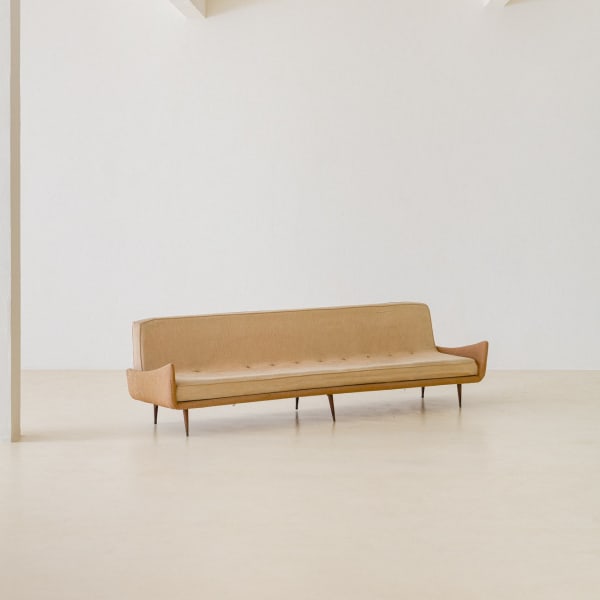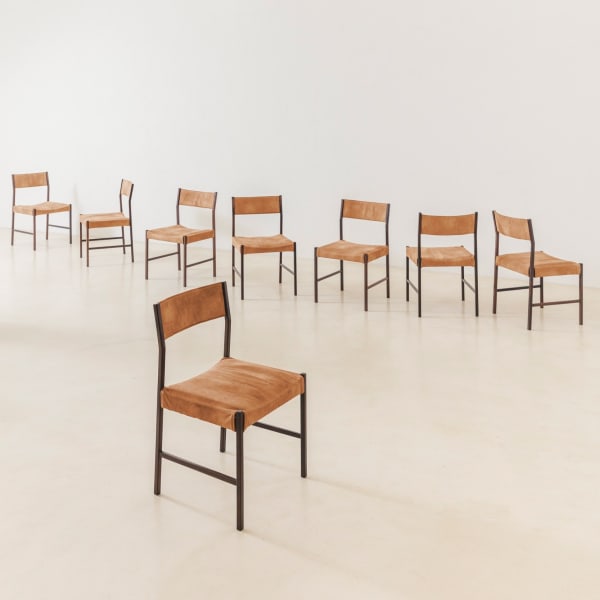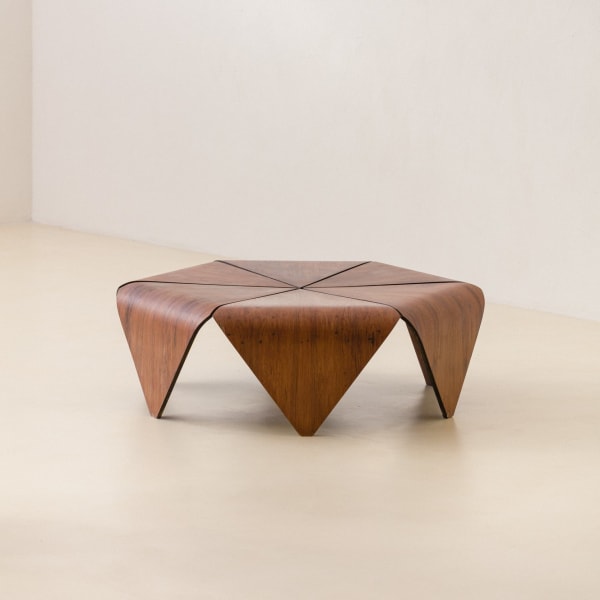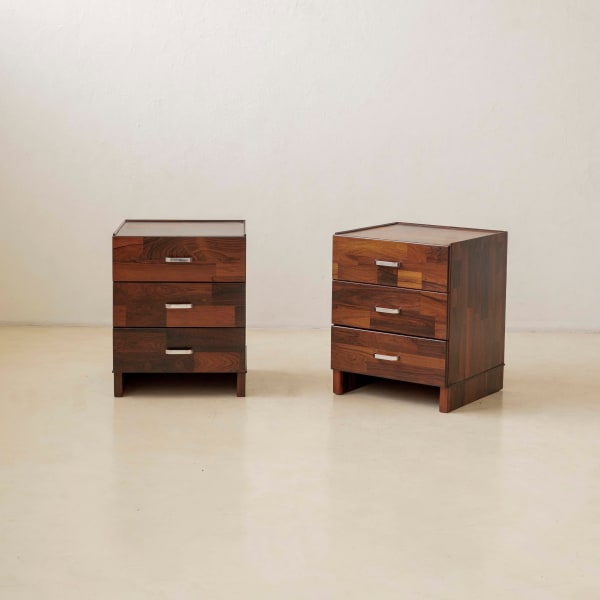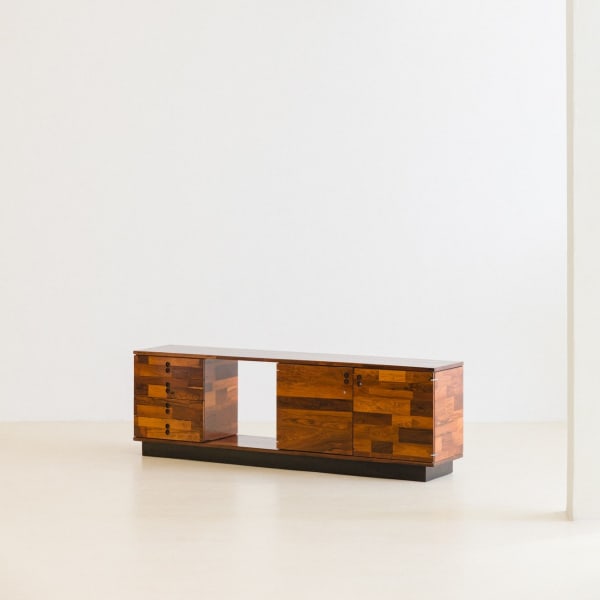-
-

-
The 1950s proved to be politically and economically favorable to initiatives related to industrial production. During this period, the city of São Paulo was entering an accelerated pace of urban expansion and verticalization. Among these initiatives, the Polish naturalized Brazilian architect Jorge Zalszupin's work presented itself as one of the most versatile.
Zalszupin was a multidisciplinary talent: architect, decorator, industrial designer, and entrepreneur. We are glad to present this viewing room focused on his production as a furniture designer, gathering some of the most representative pieces from Bossa collection. -
-
"I used to imagine that anything could be done."
Jorge Zalszupin, 2013
Born in June 1922 in Warsaw, Poland, Jorge (Jerzy) Zalszupin attended the School of Fine Arts and the Faculty of Architecture at the University of Bucharest. In 1949, Zalszupin emigrated to São Paulo, where he started working as an architect. In 1959 Zalszupin founded L'atelier Móveis, with one first collection focused on residential furniture.
-
-
1959: The earlier designs
The works of this first phase of L'Atelier put their stake on the execution and details of handmade joinery with noble materials, such as leather, marble, and rosewood, but already introduced some techniques and materials considered innovative. In the section below are some of the furniture present in archival photos of the L’Atelier store at Conjunto Nacional.
-
Zalszupin admitted that most of the things he wanted to do were either impossible or very difficult. His ideas were not limited to available technologies: the creative processes impulsioned technological innovations, and new materials generated entire product lines.
As a designer, Zalszupin deeply desired aesthetic freedom. To produce his creations, it was necessary to develop new production technics and import machinery and technologies unusual at the time in Brazil. Focusing on innovation, not only in methods but also in materials, made his production so distinctive when compared with other masters.
Zalszupin's legacy has carved his mark in Brazilian design history for many reasons: the distinction of materials, the design quality, the processes adopted, and the concept they represent as a translation of the spirit of that time. All of this was permeated by an inventive and bold spirit that made him materialize his remarkable inventions.
-
Bending the laminate wood
The molded laminated rosewood allowed the designer to execute the longed-for curves without necessarily implying adopting long and expensive manual processes. The results of molding laminates with heat inspired many of his creations and ended up becoming one of the differentials of his work in relation to the work of his contemporaries.
-
-
The Rosewood patchwork
Zalszupin also used creative alternatives to circumvent production problems, such as high costs or material shortages. The most notable of these was the marquetry finish, a process that became known as “taqueamento.” It consists of gluing various pieces of rosewood veneers of varying textures and shades on a furniture surface. This solution was widely used by him and ended up becoming one of the marks of his work.
With the use of marquetry finishing, he was able to solve several problems: it reduced the waste of material; it facilitated the process of covering large surfaces, as in table tops - since finding large rosewood trunks was already a challenge; it smoothed the variations in shades of the veneers that covered different modules of the same piece of furniture; and, finally, it made the production costs cheaper.
-
-
 Jorge ZalszupinGuanabara Table, 1960s
Jorge ZalszupinGuanabara Table, 1960s -
 Jorge ZalszupinRosewood Bench, 1960s
Jorge ZalszupinRosewood Bench, 1960s -
 Jorge ZalszupinGuanabara Table, 1959
Jorge ZalszupinGuanabara Table, 1959 -
 Jorge ZalszupinRosewood Desk, 1960s
Jorge ZalszupinRosewood Desk, 1960s -
 Jorge ZalszupinGuarujá, 1959
Jorge ZalszupinGuarujá, 1959 -
 Jorge ZalszupinBookcase, 1960s
Jorge ZalszupinBookcase, 1960s -
 Jorge ZalszupinGuanabara Table, 1959
Jorge ZalszupinGuanabara Table, 1959 -
 Jorge ZalszupinDrawer Cabinets (2 units), 1974
Jorge ZalszupinDrawer Cabinets (2 units), 1974 -
 Jorge ZalszupinGuanabara Table, 1959
Jorge ZalszupinGuanabara Table, 1959 -
 Jorge ZalszupinRosewood Credenza 'Brest', 1960s
Jorge ZalszupinRosewood Credenza 'Brest', 1960s -
 Jorge ZalszupinFolding Desk, 1974
Jorge ZalszupinFolding Desk, 1974 -
 Sergio RodriguesCredenza, 1960s
Sergio RodriguesCredenza, 1960s
-
-
-
Assemble it as you want
Zalszupin developed a line of modular furniture – one of its most successful lines. This strategy was also adopted by several of his contemporaries, such as Michel Arnoult and Geraldo de Barros. The "modulated units" consisted of several element options. Clients could choose how to assemble it to create the final furniture piece according to their taste: the number of drawers, doors, and shelves, or opt for specific compartments, such as units for radio speakers.
-
From home to office
To continue investing in technologies, it was necessary to guarantee a number of sales and a production flow. L'Atelier's growth was intensified by expanding the product portfolio with the introduction of office furniture. The sales volume of this type of furniture was higher and the market was more consistent and less subject to fads. In addition it did not require exclusive designs. However, in order not to be limited to just one type of market, Zalszupin tried to create hybrid pieces that would serve both the corporate and domestic environment.
-
-
Bold shapes from office to home
Zalszupin also developed super comfortable furniture pieces that fits to the body and bring coziness, while plays with improbable shapes and different materials. Even when following references of Scandinavian design or Organic Design, Zalszupin created a unique work, reflecting his constant search for experimentation and transformation. His upholstered designs are great examples of the boldness of these creations.
-




